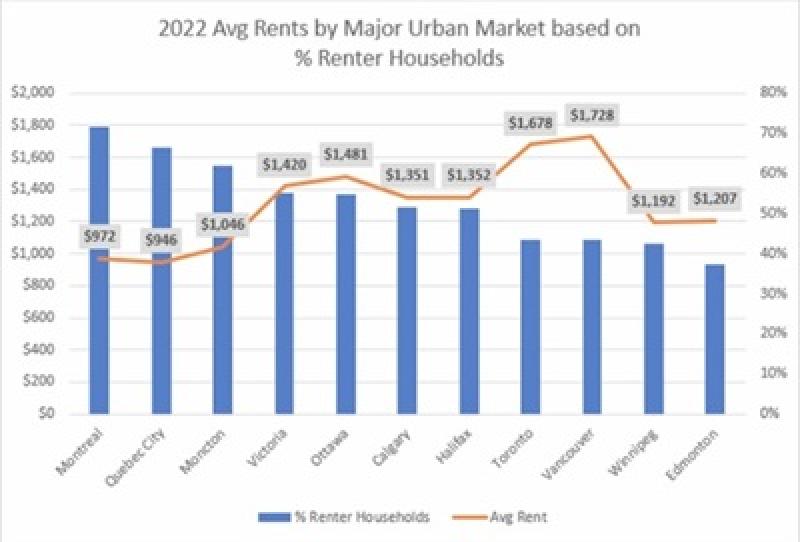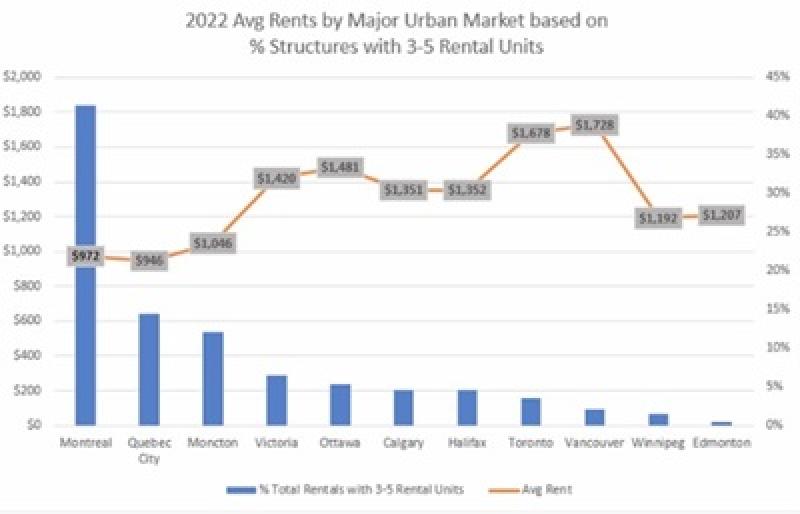
Montreal is an attractive and unique Canadian city for many reasons – from its French-Canadian culture to its festivals and thriving universities.
One additional factor that makes it stand out from other major cities in Canada is its lower average rents.
If you look at average rents across the major Canadian cities from coast to coast, you see that Montreal has among the lowest, coming in right above Quebec City.
As the graph in Chart 1 (at right, or click this link for a larger version in a pop-up window) illustrates, Montreal’s average rental rate per month in 2022 was $972, whereas cities like Toronto and Vancouver have average rents of around $1,700.
The reasons for the disparity are of course multi-faceted, but the left-hand axis helps explain it. The percentage of renter households in Montreal is the highest in the country: close to 70 per cent of households in the city are renters as opposed to owners.
Of course, it makes sense that a greater supply of apartments is going to lead to lower average rates, but there is more to it than just the number of apartments. I think it has a lot to do with the type of rental properties being offered and the culture of renting (it’s historical)

In Chart 2 (click this link for a larger version in a pop-up window) the left axis shows the percentage of properties that have just three to five rental units, i.e. triplexes and fourplexes, etc. We can see that of the 70 per cent of renters in Montreal, more than 40 per cent of those households are living in buildings with five or fewer rental units.
Why Montreal has the lowest rents
We can’t say for sure why Montreal has ended up with such a prevalence of these types of properties (duplexes, triplexes and fourplexes).
It could be because of how densely populated the island is and the fact that such buildings are more efficient ways of housing people in an urban setting. It could also be, as I mentioned previously, the cultural French ties of the city, as duplexes and triplexes are more commonly seen in Europe.
Whatever the reason, I can’t help but think that Montreal has the answer that this country is looking for amid our current housing affordability crisis.
While rental high-rise buildings can, of course, have a major impact on housing supply, these are long-term development projects that take many years to complete. They cannot solve the problem quickly enough on their own.
Instead, if we approach our housing crisis with multivariate solutions by including the development of smaller rental buildings while still developing larger rental buildings, then we might see supply being created quickly enough to satisfy the ever-increasing demand for quality rental housing.
This is why I ventured out with Rod Schulhauser, in writing the book The Self Funding House, even though it had nothing to do with our target market (apartments).
If we wait for government and apartments to solve our country’s housing crisis (which is made up of two parts; affordability and rent supply), we may not get there – simply because time is not on our side.
What if . . .
What if our entire country had the same attitude and culture about renting as in Montreal?
What if the idea of adding basement apartments to both existing and new construction homes was as common as the roughed-in basement bathroom?
What if we educated younger generations about treating their home like a business by becoming a landlord (and we aided their journey with education and access to experts)?
What would happen if we groomed a young generation to embrace an entrepreneurial mindset?
Maybe part of our crisis solution is closer than we think.
A glimpse at a needed solution
If subdivisions of new homes being built now included the option of adding a basement apartment and buyers were aware of rental income counting toward their mortgage qualification, homeownership would immediately become more attainable for many Canadians.
Rental income and understanding what that means for purchase affordability would spawn a new generation of homeowners who could help solve our crisis by learning how to create affordability for themselves.
It would also add new affordable rent supply (because these legal basement apartments rent for less than high-rise equivalents).
Let’s not forget existing housing, This works for many of these properties, too, with simple renovation projects adding basement apartments or backyard ADUs (accessory dwelling units).
I’m proud to say this is already in motion, in London Ont., in collaboration with the Ironstone Building Company and their implementation of the The Self Funding Houseconcept – Flex Haus.
This pilot project, coupled with a unique marketing strategy, received the recent OHBA Innovation Award and it’s time to make this concept mainstream in homebuilding!
The model is already in Canada
In a sense, Montreal has been living out this concept for a long time already, with the abundance of duplexes, triplexes, etc., and the rental market has seen the positive effects.
The data we’ve shared in this article shows how a housing market that takes advantage of duplexes and triplexes (i.e. The Self Funding House concept) can certainly drive down average rents – and create affordability for ownership.
Let’s hope that other major Canadian cities will follow suit and that we see housing affordability become a reality in other parts of the country as well. I think this concept is one of the keys to making this happen.
We need a plan that includes large, medium and small solutions – there is no one single solution.
